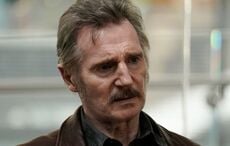Irish dance director and choreographer Breandan de Gallai has created arguably the most challenging Irish dance work ever seen on a New York stage. Noctu, which means stripped or laid bare in Irish, sweeps away everything before it in a work that breaks all the rules. CAHIR O’DOHERTY reviews the show, talks to its choreographer, and has one piece of advice for you -- kill for a ticket.
Who knew Leonard Cohen and Bjork were writing reels and jigs? They probably didn’t and -- to be honest -- until I watched Noctu at the Irish Repertory Theatre in New York I would never have imagined how effortlessly their music could lend itself to the rhythms and steps of Irish dancing.
The first thing to say about the new dance performance Noctu (the name means stripped, or laid bare in Irish) is that it is the most ambitious Irish dance work I have ever seen.
Currently playing at the Irish Rep (which is overdue an award as the most consistently brilliant theater makers in the country) through October 2, the show has been directed by the Gweedore, Co. Donegal visionary choreographer and dancer Breandan de Gallai.
The show begins with a warm-up that happens onstage. You hear the Irish accents of the dancers greeting each other as one by one they get in line (some of them turn up late, this is Ireland we’re talking about) and dance in unison. In their O’Neal and Umbro sweats they look like any young Irish person on the streets of Dublin.
It’s the most unaffected, informal way for the audience to get a sense of who these dancers are as people, but in a way it’s also very misleading, because by the end of this complex and challenging work you’ll be hard put to think of them as ordinary at all.
There’s a good reason for this -- Irish dancers aren’t. Most of them live in their calling like monks live in their faith. They are terrifically fit athletes who are also artists, and as Noctu makes clear early on, at the end of the day “they just f***ing want to dance.”
There’s a bit of Billy Elliott set up to one of the main story lines in Noctu, which seems unavoidable. For a young lad growing up in rural Ireland, becoming an Irish dancer is a bit like announcing you’re going to design women’s dresses for a living. Noctu doesn’t pretend that your path will be smooth, but it reminds you very forcefully how beautiful your life can become.
Starting out with the bluesy voice of legendary Irish chanteuse Mary Coughlan singing “Miss Brown to You,” the dancers perform a get to know you piece that’s followed up with Goldfrapp’s utterly gorgeous “Deer Stop,” and then with Kate Bush’s Irish inflexed “The Night of the Swallow.” This is seriously discerning, wildly beautiful pop music and it is matched with some impressive dancing.
“We follow those sequences up with music by a friend of mine called Joe Csibi and that’s followed by a traditional hornpipe and then by a tango,” de Gallai tells the Irish Voice. “Those sequences are followed up by Bjork’s ‘Violently Happy.’”
If you haven’t understood the beats and the rhythms of these famous tracks that take an axe to the frozen sea of Irish dance tradition you soon will when you see how they erupt onstage. Noctu is focused, energetic, and uproarious and -- yowsa -- is it sexy.
Cast members wear black kilts, then leotards, then just their underwear in a clear effort to break free from all the distracting neon colors and tossed curls that have taken over competitive Irish dancing.
Noctu isn’t making fun of all that modern showbiz excess; it just wants to purely focus on the dancing and the dancers body in motion. It’s a wise and refreshing choice.
“I came up with the idea for Noctu after I left Riverdance,” says de Gallai, who danced for years in the show himself.
“I was working with the composer Joe Csibi and I really wanted to have my own voice as a choreographer, and I realized I probably wouldn’t get to work on something on the scale of Riverdance again.”
Like most dancers, de Gallai has nothing but praise for his years in Riverdance.
“I was very, very proud to be in it and it made a huge difference to the world of Irish dancing from Tokyo to St. Petersburg. To me then and to me now it’s all about the dance,” he says.
Searching for a show of his own, created from the lessons he had learned, de Gallai took matters into his own hands when it became clear to him that it would be difficult to interest producers in any new directions for Irish dance. Michael Flatley’s success seemed to provide them all with a blueprint of the correct path to take, after all.
“Venture capitalists had a very clear idea of what the audiences wanted and they weren’t shy about saying so,” de Galli adds.
“But I was more interested in making dance from the perspective of the artist. So the argument became we know what the audience wants versus my idea that they only wanted it because that was the only thing available to them now.”
All of those financial considerations are a million miles away from the work of art that de Gallai has delivered. Quite simply it’s the most engaging and iconoclastic Irish dance performance this reviewer has ever seen.
Merging elements of hip-hop, jazz, tango and the avant-guard legacy of Martha Graham into Irish traditional dancing, it’s like punk rock meets step dancing meets Stravinsky. It’s completely mad in other words, and it will startle you with its brilliance.
De Gallai’s choreography can achieve hypnotic or thrilling broad strokes, but there are times when it falters over the subtler emotions. There’s a lack, at times, of searching tenderness or humor, and deep interaction between the dancers (although suggested) is usually kept to a minimum.
But those issues are more than made up for by the sheer ambition of what de Gallai is doing. At its best Noctu is an astounding work and it bodes very well for his future as a visionary choreographer.
What is truly remarkable about this show is that it has somehow managed to reach past the rule-bound 19th century Irish dancing tradition to a much more ancient and atavistic thrum of Ireland itself. That’s a literally incredible achievement that made some audience members almost fall of out of their chairs.
It’s the first time this reviewer has ever seen genuine violence, fury and eroticism in Irish dancing, and on seeing it I was glad of the restoration. De Gallai deserves to receive massive support to pursue his vision because it is coming from a place that runs much deeper than the bureaucrats of An Coimisiun le Rinci Gaelacha (the Irish Dancing Commission) will ever dig.
“If you do something with integrity and honesty it may be different to things that people are unaccustomed to seeing but they may enjoy it,” says de Gallai.
“Irish dancing is more than just in your feet, I believe. I have always improvised around music I enjoy myself and I consider myself to be an Irish dancer. The challenge in Noctu was to teach other Irish dancers to move that way. I had to win their confidence to do it, to let them believe in what I did.”
Now that he has found a way to communicate how easily tradition and modernity can live side by side, de Gallai has done something few Irish artists ever accomplish. He married the past and the present in a way that is recognizable and authentic.
“I’ve had my day as a dancer. Now I really want to choreograph and I really want to direct,” he adds.
“With this show and the dancing that’s in it, it’s a chance for us -- the Irish -- to tell our story and to include in it some of the characters that we meet in the wider world.”
For ticket information and showtimes, visit www.irishrep.org.




Comments